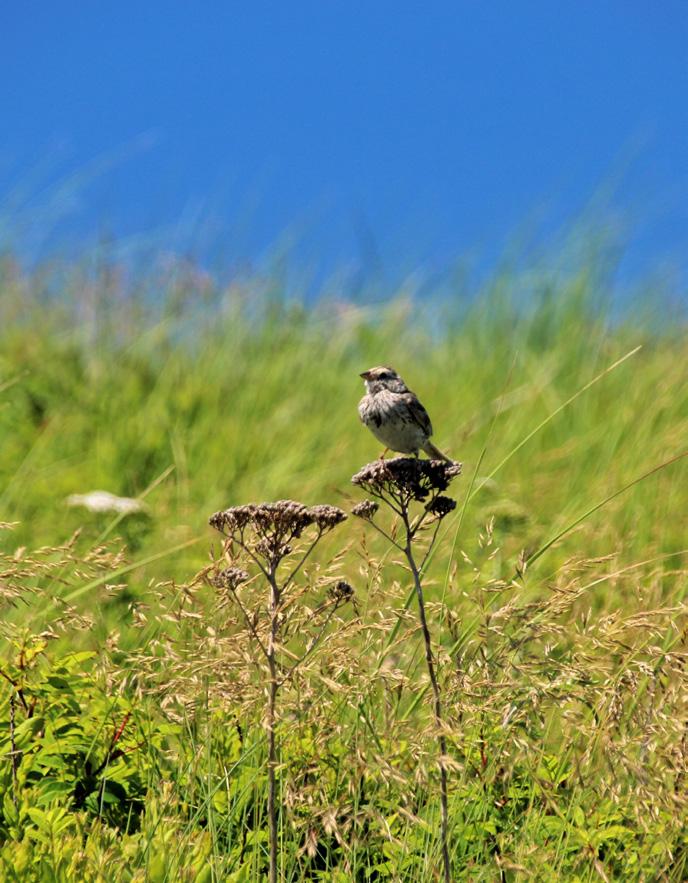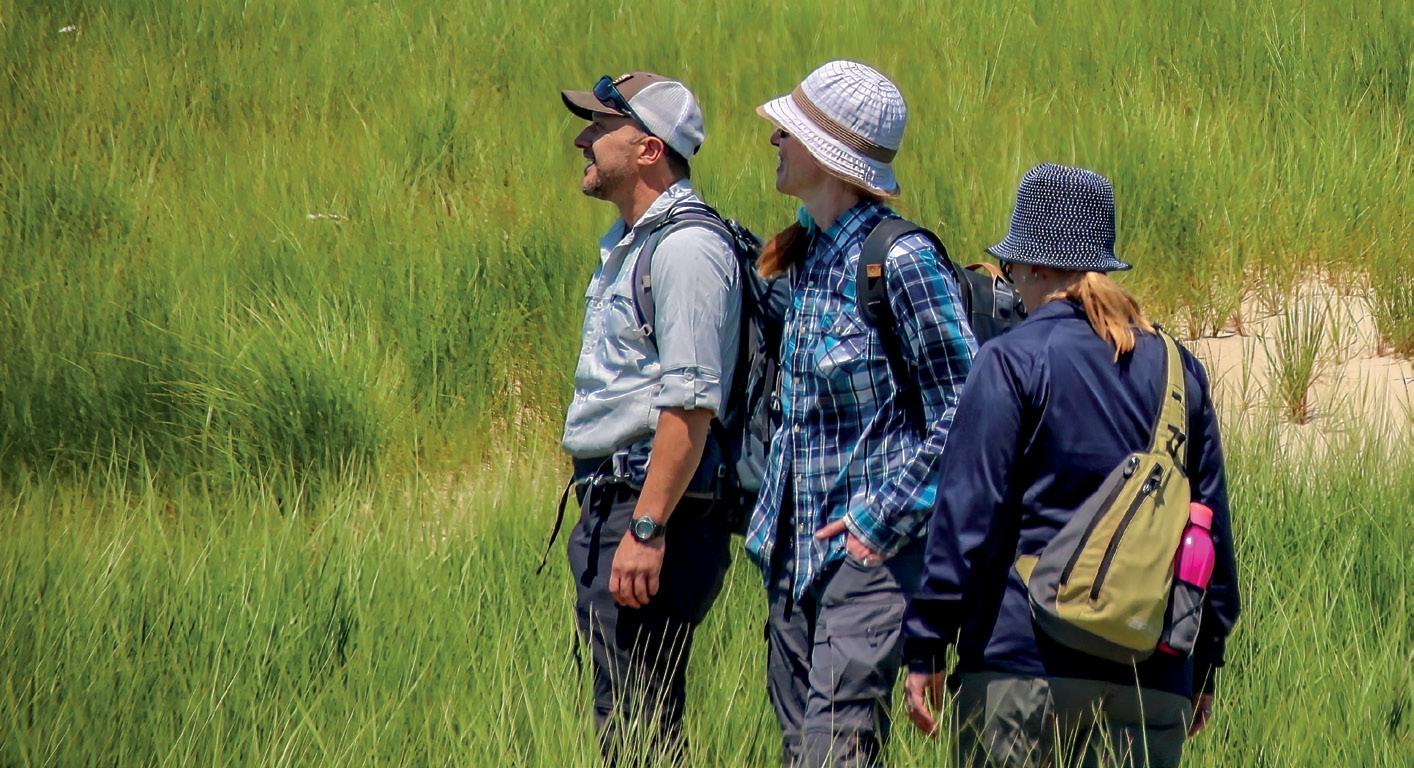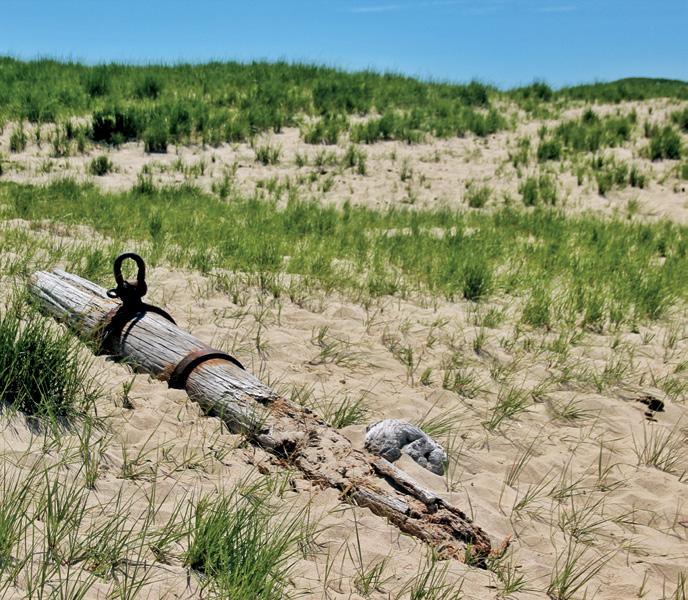
7 minute read
A Rare Encounter
How to be one of only 400 annual visitors to Sable Island
STORY AND PHOTOGRAPHY BY DARCY RHYNO
Whales!” cries a voice in my headset.
The voice comes from one of my seven fellow passengers aboard our helicopter flight to Sable Island. Silhouetted against the sandy ocean floor below, a dark, torpedo shape breaks the surface. Another, smaller one breaks just behind — a mother minke and her calf.
Someone else calls out, “Is that a shark?” and points out a smaller torpedo, this one just beneath the surface.
“One of 18 species found in these waters,” says Fred Stillman, owner of Kattuk Expeditions. He’s our guide on this 350-kilometre, 75-minute flight from Fox Harb’r Resort in Wallace to the lonesome, 42-kilometre crescent of sand off Nova Scotia’s coast, now a national park reserve.
Peering over the pilots’ shoulders, I see a silver thread woven into a turquoise tapestry — the island’s western tip. The chopper follows the coastline over grassy dunes to a concrete pad a kilometre from Sable Island Station where visiting scientists and park rangers stay.
It feels good to unbuckle and stretch our legs. Sand dunes stretch east and west as far as I can see. We walk single file to reduce our harm to the sensitive vegetation. Arriving at a pond, we spot some of Sable Island’s 500 wild horses, the main attraction for many of today’s adventurers.
“We have always loved horses since we were little girls,” says one woman here with her sister. “It’s a bucket-list item.”
As we hike, little Ipswich sparrows chirp and flit about, trying to lure us away from their nests atop the dunes. Sable is one of the few places on Earth where this subspecies breeds. We wind through the dunes, careful not to step on orchids, beach pea, and wild roses blooming among the native marram grass that holds the sand in place and feeds the horses.
Horses have lived here for nearly three centuries. Thomas Hancock, a ship owner, confiscated horses, sheep, cows, pigs, and goats from the Acadians that British colonial officials hired him to deport from Nova Scotia during the Great Expulsion of 1755. He shipped the animals here with plans to later retrieve and sell them. Only the horses survived. Hancock never returned.
Stillman asks that we keep at least 20 metres from the wild horses. We watch three distinct bands of horses graze, drink, play, and rest. A stallion leads each group, which consists of several mares and a foal or two. For the bird watchers, 25 short-billed dowagers and a dozen least sandpipers wade in the shallows.
Four horses stand nose to nose, as if talking things over. Others appear over the dunes, making their way to the pond to drink. In total, 31 gather around the pond. Stillman tells us the horses are relaxed in our presence because the island has no predators. Nor does it have mosquitoes, blackflies, or ticks. There’s lots of food for the horses. When the ponds are low, they dig for water.
Once the horse enthusiasts are satisfied, we trek through the dunes to the station. As we arrive, a bird dive bombs Stillman. He ducks and laughs, less startled than the rest of us because he’s used to scouts from the nearby nesting colony of 6,000 Arctic terns warning humans away. The raucous squawking from the colony grows louder until we reach the station.

A lone horse wanders the shoreline.
Photo: Darcy Rhyno

Ipswich sparrows breed on the island.
Photo: Darcy Rhyno
There, we tuck into our packed lunches from Fox Harb’r Resort as part of the package that includes two night’s accommodations, a spa treatment, and this trip. When Zoe Lucas arrives to speak with us, it’s like meeting a celebrity. For more than 50 years, she’s been a permanent though part-time resident on the island, doing scientific research.
After lunch, Lucas leads us through the dunes and onto the northern sand flats where we watch a Sable Aviation plane land, another way to reach the island. Adventure Canada also offers cruises that include a stop on the island. Picture Perfect and Kattuk Expeditions offer tours as well. Landing by private vessel is allowed with permission from Parks Canada.

Guide Fred Stillman with tour participants.
Photo: Darcy Rhyno
On our way to the southern beach, we find a horse carcass. Lucas says other horses stayed with this mare as she weakened and died. “They’ll graze nearby and nuzzle. If the horse is a member of a band, it won’t be dying alone.”
We find wreckage from one of the 350 ships that have met their fate here since the 16th century, lending Sable the nickname “Graveyard of the Atlantic.” Further along, we startle several hundred grey seals from their basking places back into the surf. Some 400,000 breed here, making it the world’s largest colony. The shores of Sable come alive in January when they give birth to some 80,000 pups, and again in March when the seals molt.
Back at the helicopter pad, Stillman announces, “Folks, I did bring a treat for the end of the day.” He pops a bottle of champagne and pours us a round. Standing in a circle, the sun illuminating the bubbles in our glasses, we toast our rare, shared expedition to one of the world’s great wildlife reserves.

Wreckage from a ship long ago.
Photo: Darcy Rhyno

Seals take to the water as we pass.
Photo: Darcy Rhyno
Lobster Stuffed Digby Scallops From Fox Harb’r Resort
Ingredients
4 Large Scallops
2 oz (56 mL) chopped lobster
1 oz (28 mL) cream cheese
2 large potatoes
1 small head of celeriac
3 ½ oz (100 mL) heavy cream
2 oz (56 mL) unsalted butter
1 small bunch of chives
6 oz (170 mL) olive oil
8 ½ oz (250 mL) white wine
1 shallot, finely diced
4 oz (125 mL) unsalted butter
¼ oz (7 mL) caviar
Seasonal vegetable to garnish
Directions
Make a large slice in the side of the scallops so they open up in half. Mix chopped lobster and cream cheese. Season with salt and pepper. Stuff the lobster mixture into the scallop and fold back over. Cool in fridge before cooking
Peel and large dice potatoes and celeriac. Place in water and boil until tender. Strain and push through ricer. Mix in heavy cream and butter. Season with salt and pepper and keep warm.
To make chive oil, place a bunch of chives in a blender with half the olive oil. Blend well, then add the rest of the olive oil. Let stand for 1 hour. Strain through cheesecloth for a bright green chiveflavoured oil.
To make beurre blanc, sauté the shallot in a little olive oil. Add white wine. Reduce by two thirds and reduce heat to keep warm. Slowly add butter and whisk until well incorporated. Strain out shallots. Season with salt and pepper. At the last moment, fold in the caviar so it remains fresh. Caviar is a little salty, so don’t over-season the sauce.
Cook scallops in a very hot pan with a touch of canola or grapeseed oil, two minutes per side. Try for a golden sear on both sides. The lobster mixture will just warm. Don’t overheat or the cream cheese will melt.
Place four ounces (about 120 mL) of potato/celeriac purée in the middle of the plate. With the back of a spoon, smear the tail end of the mixture so it draws toward the edge of the plate. Place four scallops on the side of the purée, seasonal vegetable on the other side and spoon a tablespoon of the sauce over each scallop. Garnish with a sprig of herb or micro greens.

